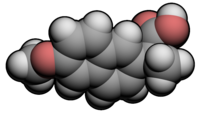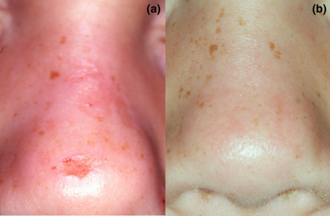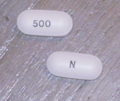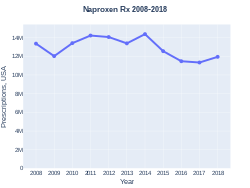Naproxen
 | |
 | |
| Names | |
|---|---|
| Pronunciation | /nəˈprɒksən/ |
| Trade names | Aleve, Naprosyn, others[1] |
| |
| Clinical data | |
| Drug class | Nonsteroidal anti-inflammatory drug (NSAID)[2] |
| Main uses | Pain, menstrual cramps, inflammatory diseases, fever[2] |
| Side effects | Dizziness, headache, bruising, allergic reactions, heartburn, stomach pain[2] |
| Pregnancy category | |
| Routes of use | By mouth |
| Defined daily dose | 500 mg[4] |
| External links | |
| AHFS/Drugs.com | Monograph |
| MedlinePlus | a681029 |
| Legal | |
| License data | |
| Legal status |
|
| Pharmacokinetics | |
| Bioavailability | 95% (by mouth) |
| Protein binding | 99% |
| Metabolism | Liver (to 6-desmethylnaproxen) |
| Elimination half-life | 12–17 hours (adults)[7] |
| Excretion | Kidney |
| Chemical and physical data | |
| Formula | C14H14O3 |
| Molar mass | 230.263 g·mol−1 |
| 3D model (JSmol) | |
| Melting point | 152–154 °C (306–309 °F) |
| |
| |
Naproxen, sold under the brand name Aleve among others, is a nonsteroidal anti-inflammatory drug (NSAID) used to treat pain, menstrual cramps, inflammatory diseases such as rheumatoid arthritis, and fever.[2] It is taken by mouth.[2] It is available in immediate and delayed release formulations.[2] Onset of effects is within an hour and last for up to twelve hours.[2]
Common side effects include dizziness, headache, bruising, allergic reactions, heartburn, and stomach pain.[2] Severe side effects include an increased risk of heart disease, stroke, gastrointestinal bleeding, and stomach ulcers.[2] The heart disease risk may be lower than with other NSAIDs.[2] It is not recommended in people with kidney problems.[2] Use is not recommended in the third trimester of pregnancy.[2]
Naproxen is a nonselective COX inhibitor.[2] It is in the propionic acid class of medications.[2] As an NSAID, naproxen appears to exert its anti-inflammatory action by reducing the production of inflammatory mediators called prostaglandins.[8] It is metabolized by the liver to inactive metabolites.[2]
Naproxen was patented in 1967, and approved for medical use in the United States in 1976.[9][2][10] It is available over the counter and as a generic medication.[2][11] In the United Kingdom it cost about £0.15 per dose in 2017.[12] In the United States, the wholesale cost per dose is less than US$0.10 as of 2018.[13] In 2017, it was the 71st most commonly prescribed medication in the United States, with more than eleven million prescriptions.[14][15]
Medical uses
Naproxen's medical uses are related to its mechanism of action as an anti-inflammatory compound.[9] Naproxen is used to treat a variety of inflammatory conditions and symptoms that are due to excessive inflammation, such as pain and fever (naproxen has fever-reducing, or antipyretic, properties in addition to its anti-inflammatory activity).[9] Notably, not all medications that reduce fever are anti-inflammatory compounds (such as paracetamol).[medical citation needed] Inflammatory sources of pain that may respond to naproxen's anti-inflammatory activity are conditions such as migraine, osteoarthritis, kidney stones, rheumatoid arthritis, psoriatic arthritis, gout, ankylosing spondylitis, menstrual cramps, tendinitis, and bursitis.[1]
Naproxen sodium is used as a "bridge therapy" in medication-overuse headache to slowly take patients off other medications.[16]
Dosage
The defined daily dose is 500 mg by mouth or rectally.[4]
Formulations
Naproxen sodium is available as both an immediate release and as an extended release tablet. The extended release formulations (sometimes called "sustained release," or "enteric coated") take longer to take effect than the immediate release formulations, and therefore are less useful when immediate pain relief is desired. Extended release formulations are more useful for the treatment of chronic, or long-lasting, conditions, in which long-term pain relief is desirable.[17]
-
250 mg tablet of naproxen
-
220 mg tablet of naproxen sodium. Imprint L490 (upside-down). Round, light blue tablet.[17]
-
Naproxen extended release 500 mg, back and front.
Side effects

Common adverse effects include dizziness, drowsiness, headache, rash, bruising, and gastrointestinal upset.[9][1] Heavy use is associated with increased risk of end-stage renal disease and kidney failure.[9][18] Naproxen may cause muscle cramps in the legs in 3% of people.[19]
Gastrointestinal
As with other non-COX-2 selective NSAIDs, naproxen can cause gastrointestinal problems, such as heartburn, constipation, diarrhea, ulcers and stomach bleeding.[20] Naproxen should be taken orally with food to decrease the risk of gastrointestinal side effects.[citation needed] Persons with a history of ulcers or inflammatory bowel disease should consult a doctor before taking naproxen.[citation needed] In U.S. markets, naproxen is sold with boxed warnings about the risk of gastrointestinal ulceration or bleeding.[1] Naproxen poses an intermediate risk of stomach ulcers compared with ibuprofen, which is low-risk, and indometacin, which is high-risk.[21] To reduce stomach ulceration risk, it is often combined with a proton-pump inhibitor (a medication that reduces stomach acid production) during long-term treatment of those with pre-existing stomach ulcers or a history of developing stomach ulcers while on NSAIDs.[22][23]
Cardiovascular
COX-2 selective and nonselective NSAIDs have been linked to increases in the number of serious and potentially fatal cardiovascular events, such as myocardial infarctions and strokes.[24] Naproxen is, however, associated with the smallest overall cardiovascular risks.[25][26] Cardiovascular risk must be considered when prescribing any nonsteroidal anti-inflammatory drug. The drug had roughly 50% of the associated risk of stroke compared with ibuprofen, and was also associated with a reduced number of myocardial infarctions compared with control groups.[25]
A study found that high-dose naproxen induced near-complete suppression of platelet thromboxane throughout the dosing interval and appeared not to increase cardiovascular disease (CVD) risk, whereas other non-aspirin high-dose NSAID regimens had only transient effects on platelet COX-1 and were associated with a small but definite vascular hazard. Conversely, naproxen was associated with higher rates of upper gastrointestinal bleeding complications compared with other NSAIDs.[26]
Pregnancy and lactation
Small amounts of naproxen are excreted in breast milk.[1] However, adverse effects are uncommon in infants breastfed from mother taking naproxen.[27]
Interactions
Drug–drug
Naproxen may interact with antidepressants, lithium, methotrexate, probenecid, warfarin and other blood thinners, heart or blood pressure medications, including diuretics, or steroid medicines such as prednisone.[1]
NSAIDs such as naproxen may interfere with and reduce the efficacy of SSRI antidepressants,[28] as well as increase the risk of bleeding greater than the individual bleeding risk of either class of agent when taken together.[29] Naproxen is not contraindicated in the presence of SSRIs, though concomitant use of the medications should be done with caution.[29]
Drug–food
Alcohol consumption increases the risk of gastrointestinal bleeding when combined with NSAIDs like naproxen in a dose-dependent manner (that is, the higher the dose of naproxen, the higher the risk of bleeding).[30] The risk is highest for people who are heavy drinkers.[30]
Pharmacology
Mechanism of action
Naproxen works by reversibly inhibiting both the COX-1 and COX-2 enzymes as a non-selective coxib.[31][32][33][34][35] This results in the inhibition of prostaglandin synthesis. Prostaglandins act as signaling molecules in the body, inducing inflammation. Thus, by inhibiting COX-1/2, naproxen induces an anti-inflammatory effect.
Pharmacokinetics
Naproxen is a minor substrate of CYP1A2 and CYP2C9. It is extensively metabolized in the liver to 6-O-desmethylnaproxen, and both the parent drug and the desmethyl metabolite undergo further metabolism to their respective acylglucuronide conjugated metabolites.[36] An analysis of two clinical trials shows that naproxen's time to peak plasma concentration occurs between 2–4 hours after oral administration, though naproxen sodium reaches peak plasma concentrations within 1–2 hours.[7]
Pharmacogenetics
The pharmacogenetics of naproxen has been studied in an effort to better understand its adverse effects.[37] In 1998, a small pharmacokinetic (PK) study failed to show that differences in a patient's ability to clear naproxen from the body could account for differences in a patient's risk of experiencing the adverse effect of a serious gastrointestinal bleed while taking naproxen.[37] However, the study failed to account for differences in the activity of CYP2C9, a drug metabolizing enzyme responsible for clearing naproxen.[37] Studies on the relationship between CYP2C9 genotype and NSAID-induced gastrointestinal bleeds have shown that genetic variants in CYP2C9 that reduce the clearance of major CYP2C9 substrates (like naproxen) increase the risk of NSAID-induced gastrointestinal bleeds, especially for homozygous defective variants.[37]
As of October 2017[update], there are no recommendations for routine CYP2C9 testing for naproxen.[38]
Chemistry
Naproxen is a member of the 2-arylpropionic acid (profen) family of NSAIDs.[39] The free acid is an odorless, white to off-white crystalline substance.[citation needed] It is lipid-soluble and practically insoluble in water. It has a melting point of 152–155 °C.[citation needed]
Synthesis
Naproxen has been industrially produced by Syntex starting from 2-naphthol as follows:[40]
Society and culture
Cost
In the United Kingdom it cost about £0.15 per dose in 2017.[12] In the United States, the wholesale cost per dose is less than US$0.10 as of 2018.[13] In 2017, it was the 71st most commonly prescribed medication in the United States, with more than eleven million prescriptions.[14][15]
-
Naproxen costs (US)
-
Naproxen prescriptions (US)
Brand names
Naproxen and naproxen sodium are marketed under various brand names, including: Synflex, Aleve, Accord, Anaprox, Antalgin, Apranax, Feminax Ultra, Flanax, Inza, Maxidol, Midol Extended Relief, Nalgesin, Naposin, Naprelan, Naprogesic, Naprosyn, Narocin, Pronaxen, Proxen, Soproxen, MotriMax, and Xenobid.[citation needed] It is also available as the combination naproxen/esomeprazole magnesium in delayed release tablets under the brand name Vimovo.[41]
Access restrictions
Syntex first marketed naproxen in 1976, as the prescription drug Naprosyn. They first marketed naproxen sodium under the brand name Anaprox in 1980. It remains a prescription-only drug in much of the world.[citation needed] In the United States, the Food and Drug Administration (FDA) approved it as an over-the-counter (OTC) drug in 1994. OTC preparations of naproxen in the U.S. are mainly marketed by Bayer HealthCare under the brand name Aleve and generic store brand formulations in 220 mg tablets.[42] In Australia, packets of 275 mg tablets of naproxen sodium are Schedule 2 pharmacy medicines, with a maximum daily dose of five tablets or 1375 mg. In the United Kingdom, 250 mg tablets of naproxen were approved for OTC sale under the brand name Feminax Ultra in 2008, for the treatment of primary dysmenorrhoea in women aged 15 to 50.[43] In the Netherlands, 220 mg and 275 mg tablets are available OTC in drugstores, 550 mg is OTC only at pharmacies. Aleve became available over the counter in most provinces in Canada on 14 July 2009, but not British Columbia, Quebec or Newfoundland and Labrador;[44] it subsequently became available OTC in British Columbia in January 2010.[45]
Research
Naproxen may have antiviral activity against influenza. In laboratory research, it blocks the RNA-binding groove of the nucleoprotein of the virus, preventing formation of the ribonucleoprotein complex—thus taking the viral nucleoproteins out of circulation.[46]
Diagnostics
Naproxen has been used to differentiate between infectious fevers and neoplastic or connective tissue disease-related fevers.[47] Although the literature is inconclusive, it is thought that naproxen may help differentiate between infectious fevers and neoplastic fevers by its efficacy in reducing them; in some studies, naproxen reduced neoplastic fevers better than it reduced infectious fevers.[48]
Veterinary use
Horses
Naproxen is given by mouth to horses at a dose of 10 mg/kg, and has shown to have a wide safety margin (no toxicity when given at three times the recommended dose for 42 days).[49] It is more effective for myositis than the commonly used NSAID phenylbutazone, and has shown especially good results for treatment of equine exertional rhabdomyolysis,[50] a disease of muscle breakdown, but is less commonly used for musculoskeletal disease.[medical citation needed]
References
- ↑ 1.0 1.1 1.2 1.3 1.4 1.5 "Naproxen". Drugs.com. 2017. Archived from the original on 8 February 2017. Retrieved 7 February 2017.
- ↑ 2.00 2.01 2.02 2.03 2.04 2.05 2.06 2.07 2.08 2.09 2.10 2.11 2.12 2.13 2.14 2.15 2.16 "Naproxen Monograph for Professionals". Drugs.com. AHFS. Archived from the original on 20 December 2018. Retrieved 19 December 2018.
- ↑ 3.0 3.1 "Naproxen Use During Pregnancy". Drugs.com. 13 August 2019. Archived from the original on 5 June 2019. Retrieved 27 December 2019.
- ↑ 4.0 4.1 "WHOCC - ATC/DDD Index". www.whocc.no. Archived from the original on 4 August 2020. Retrieved 9 September 2020.
- ↑ Gill, A, ed. (July 2013). Standard for the Uniform Scheduling of Medicines and Poisons No. 4 (PDF). The Poisons Standard 2013. Therapeutic Goods Administration. ISBN 978-1-74241-895-7. Archived from the original on 15 October 2014. Retrieved 27 April 2015.
- ↑ "NAPROXEN". British National Formulary. Archived from the original on 28 August 2021.
- ↑ 7.0 7.1 Angiolillo DJ, Weisman SM (April 2017). "Clinical Pharmacology and Cardiovascular Safety of Naproxen". American Journal of Cardiovascular Drugs. 17 (2): 97–107. doi:10.1007/s40256-016-0200-5. PMC 5340840. PMID 27826802.
- ↑ McEvoy, Gerald K. (2000). AHFS Drug Information, 2000. American Society of Health-System Pharmacists. p. 1854. ISBN 9781585280049. Archived from the original on 6 August 2020. Retrieved 22 May 2020.
- ↑ 9.0 9.1 9.2 9.3 9.4 "Naprosyn- naproxen tablet EC-Naprosyn- naproxen tablet, delayed release Anaprox DS- naproxen sodium tablet". DailyMed. 1 July 2019. Archived from the original on 8 August 2020. Retrieved 27 December 2019.
- ↑ Fischer, Jnos; Ganellin, C. Robin (2006). Analogue-based Drug Discovery. John Wiley & Sons. p. 520. ISBN 9783527607495. Archived from the original on 6 August 2020. Retrieved 22 May 2020.
- ↑ "Medicines A to Z - Naproxen". NHS. National Health Service. 24 October 2018. Archived from the original on 30 June 2020. Retrieved 11 March 2020.
- ↑ 12.0 12.1 British national formulary : BNF 74 (74 ed.). British Medical Association. 2017. pp. 1048–1049. ISBN 978-0857112989.
- ↑ 13.0 13.1 "NADAC as of 2018-12-19". Centers for Medicare and Medicaid Services. Archived from the original on 19 December 2018. Retrieved 22 December 2018.
- ↑ 14.0 14.1 "The Top 300 of 2020". ClinCalc. Archived from the original on 12 February 2021. Retrieved 11 April 2020.
- ↑ 15.0 15.1 "Naproxen - Drug Usage Statistics". ClinCalc. Archived from the original on 12 April 2020. Retrieved 11 April 2020.
- ↑ Garza, Ivan; Schwedt, Todd J. (2010). "Diagnosis and Management of Chronic Daily Headache". Seminars in Neurology. WebMD LLC. 30 (2): 154–66. doi:10.1055/s-0030-1249224. PMID 20352585. Archived from the original on 11 May 2017. Retrieved 17 May 2017.
- ↑ 17.0 17.1 "L490 (Naproxen 220 mg)". drugs.com. Drugs.com. Archived from the original on 17 March 2018. Retrieved 17 May 2017.
- ↑ Perneger TV, Whelton PK, Klag MJ (22 December 1994). "Risk of Kidney Failure Associated with the Use of Acetaminophen, Aspirin, and Nonsteroidal Antiinflammatory Drugs". New England Journal of Medicine. 331 (25): 1675–1679. doi:10.1056/nejm199412223312502. ISSN 0028-4793. PMID 7969358.
- ↑ Allen, RE; Kirby, KA (2012). "Nocturnal leg cramps". Am Fam Physician. 86 (4): 350–355. PMID 22963024.
- ↑ "Naproxen". PubMed Health. 1 September 2008. Archived from the original on 22 July 2010.
- ↑ Richy F, Bruyere O, Ethgen O, Rabenda V, Bouvenot G, Audran M, et al. (July 2004). "Time dependent risk of gastrointestinal complications induced by non-steroidal anti-inflammatory drug use: a consensus statement using a meta-analytic approach". Annals of the Rheumatic Diseases. 63 (7): 759–66. doi:10.1136/ard.2003.015925. PMC 1755051. PMID 15194568.
- ↑ Rossi S, ed. (2013). Australian Medicines Handbook (2013 ed.). Adelaide: The Australian Medicines Handbook Unit Trust. ISBN 978-0-9805790-9-3.
- ↑ Joint Formulary Committee (2013). British National Formulary (BNF) (65 ed.). London, UK: Pharmaceutical Press. pp. 665, 673. ISBN 978-0-85711-084-8.
- ↑ Nissen SE, Yeomans ND, Solomon DH, Lüscher TF, Libby P, Husni ME, et al. (December 2016). "Cardiovascular Safety of Celecoxib, Naproxen, or Ibuprofen for Arthritis". The New England Journal of Medicine. 375 (26): 2519–29. doi:10.1056/NEJMoa1611593. PMID 27959716.
- ↑ 25.0 25.1 Trelle S, Reichenbach S, Wandel S, Hildebrand P, Tschannen B, Villiger PM, et al. (January 2011). "Cardiovascular safety of non-steroidal anti-inflammatory drugs: network meta-analysis". BMJ. 342: c7086. doi:10.1136/bmj.c7086. PMC 3019238. PMID 21224324. c7086.
- ↑ 26.0 26.1 Bhala N, Emberson J, Merhi A, Abramson S, Arber N, Baron JA, et al. (August 2013). "Vascular and upper gastrointestinal effects of non-steroidal anti-inflammatory drugs: meta-analyses of individual participant data from randomised trials". Lancet. 382 (9894): 769–79. doi:10.1016/S0140-6736(13)60900-9. PMC 3778977. PMID 23726390.
- ↑ "LACTMED: NAPROXEN". TOXNET. NIH. Archived from the original on 18 October 2017. Retrieved 21 July 2017.
- ↑ Warner-Schmidt JL, Vanover KE, Chen EY, Marshall JJ, Greengard P (May 2011). "Antidepressant effects of selective serotonin reuptake inhibitors (SSRIs) are attenuated by antiinflammatory drugs in mice and humans". Proceedings of the National Academy of Sciences of the United States of America. 108 (22): 9262–7. Bibcode:2011PNAS..108.9262W. doi:10.1073/pnas.1104836108. PMC 3107316. PMID 21518864.
- ↑ 29.0 29.1 Turner MS, May DB, Arthur RR, Xiong GL (March 2007). "Clinical impact of selective serotonin reuptake inhibitors therapy with bleeding risks". Journal of Internal Medicine. 261 (3): 205–13. doi:10.1111/j.1365-2796.2006.01720.x. PMID 17305643.
- ↑ 30.0 30.1 Pfau PR, Lichenstein GR (November 1999). "NSAIDs and alcohol: never the twain shall mix?". The American Journal of Gastroenterology. 94 (11): 3098–101. PMID 10566697.
- ↑ Duggan KC, Walters MJ, Musee J, Harp JM, Kiefer JR, Oates JA, et al. (November 2010). "Molecular basis for cyclooxygenase inhibition by the non-steroidal anti-inflammatory drug naproxen". The Journal of Biological Chemistry. 285 (45): 34950–9. doi:10.1074/jbc.M110.162982. PMC 2966109. PMID 20810665.
- ↑ Hinz B, Cheremina O, Besz D, Zlotnick S, Brune K (April 2008). "Impact of naproxen sodium at over-the-counter doses on cyclooxygenase isoforms in human volunteers". International Journal of Clinical Pharmacology and Therapeutics. 46 (4): 180–6. doi:10.5414/CPP46180. PMID 18397691.
- ↑ Van Hecken A, Schwartz JI, Depré M, De Lepeleire I, Dallob A, Tanaka W, et al. (October 2000). "Comparative inhibitory activity of rofecoxib, meloxicam, diclofenac, ibuprofen, and naproxen on COX-2 versus COX-1 in healthy volunteers". Journal of Clinical Pharmacology. 40 (10): 1109–20. doi:10.1177/009127000004001005 (inactive 30 April 2020). PMID 11028250. Archived from the original on 23 February 2020. Retrieved 23 February 2020.
{{cite journal}}: CS1 maint: DOI inactive as of April 2020 (link) - ↑ Gross GJ, Moore J (July 2004). "Effect of COX-1/COX-2 inhibition versus selective COX-2 inhibition on coronary vasodilator responses to arachidonic acid and acetylcholine". Pharmacology. 71 (3): 135–42. doi:10.1159/000077447. PMID 15161995.
- ↑ Hawkey CJ (October 2001). "COX-1 and COX-2 inhibitors". Best Practice & Research. Clinical Gastroenterology. 15 (5): 801–20. doi:10.1053/bega.2001.0236. PMID 11566042.
- ↑ Vree TB, van den Biggelaar-Martea M, Verwey-van Wissen CP, Vree JB, Guelen PJ (August 1993). "Pharmacokinetics of naproxen, its metabolite O-desmethylnaproxen, and their acyl glucuronides in humans". Biopharmaceutics & Drug Disposition. 14 (6): 491–502. doi:10.1002/bdd.2510140605. PMID 8218967.
- ↑ 37.0 37.1 37.2 37.3 Rodrigues AD (November 2005). "Impact of CYP2C9 genotype on pharmacokinetics: are all cyclooxygenase inhibitors the same?". Drug Metabolism and Disposition. 33 (11): 1567–75. doi:10.1124/dmd.105.006452. PMID 16118328.
- ↑ "CYP2C9". pharmgkb.org. PharmGKB. Archived from the original on 13 July 2017. Retrieved 17 May 2017.
- ↑ el Mouelhi M, Ruelius HW, Fenselau C, Dulik DM (1987). "Species-dependent enantioselective glucuronidation of three 2-arylpropionic acids. Naproxen, ibuprofen, and benoxaprofen". Drug Metabolism and Disposition. 15 (6): 767–72. PMID 2893700.
- ↑ Harrington PJ, Lodewijk E (1997). "Twenty Years of Naproxen Technology". Org. Process Res. Dev. 1 (1): 72–76. doi:10.1021/op960009e.
- ↑ "Vimovo- naproxen and esomeprazole magnesium tablet, delayed release". DailyMed. 2 August 2019. Archived from the original on 24 August 2019. Retrieved 27 December 2019.
- ↑ "Aleve- naproxen sodium tablet". DailyMed. 4 November 2019. Archived from the original on 9 August 2020. Retrieved 27 December 2019.
- ↑ "Medicines regulator approves availability of a new OTC medicine for period pain" (Press release). Medicines and Healthcare products Regulatory Agency (MHRA). 1 April 2008. Archived from the original (PDF) on 21 September 2013.
- ↑ "Aleve – Welcome to Canada, Eh!" (PDF) (Press release). Bayer Health Care. 14 July 2009. Archived (PDF) from the original on 1 February 2010. Retrieved 24 March 2012.
- ↑ "Aleve – Helping British Columbians with Joint and Arthritis Pain Get Back to Doing the Activities They Love". newswire.ca. 28 January 2010. Archived from the original on 21 September 2013. Retrieved 27 September 2012.
- ↑ Lejal N, Tarus B, Bouguyon E, Chenavas S, Bertho N, Delmas B, et al. (May 2013). "Structure-based discovery of the novel antiviral properties of naproxen against the nucleoprotein of influenza A virus". Antimicrobial Agents and Chemotherapy. 57 (5): 2231–42. doi:10.1128/AAC.02335-12. PMC 3632891. PMID 23459490.
- Lay summary in: "Pain reliever shows anti-viral activity against flu". EurekAlert!.
- ↑ Zell JA, Chang JC (November 2005). "Neoplastic fever: a neglected paraneoplastic syndrome". Supportive Care in Cancer. 13 (11): 870–7. doi:10.1007/s00520-005-0825-4. PMID 15864658.
- ↑ Kudlowitz, David. "Neoplastic Fever: Pathophysiology, Clinical Features, And Diagnostic Assessment". Clinical Correlations. New York University. Archived from the original on 19 June 2017. Retrieved 4 May 2017.
- ↑ McIlwraith, C. W.; Frisbie, D. D.; Kawcak, C. E. (2001). "Nonsteroidal Anti-Inflammatory Drugs". Proceedings of the Annual Convention of the American Association of Equine Practitioners. 47: 182–187. ISSN 0065-7182.
- ↑ May, S. A.; Lees, P. (1996). "Nonsteroidal anti-inflammatory drugs". In McIlwraith, C. W.; Trotter, G. W. (eds.). Joint disease in the horse. Philadelphia: WB Saunders. pp. 223–237. ISBN 0-7216-5135-6.
External links
| External sites: | |
|---|---|
| Identifiers: |
| Look up naproxen in Wiktionary, the free dictionary. |
- Pages using duplicate arguments in template calls
- CS1 maint: DOI inactive as of April 2020
- Articles with hatnote templates targeting a nonexistent page
- Use dmy dates from December 2019
- Articles with invalid date parameter in template
- Chemical articles with unknown parameter in Infobox drug
- Chemical articles without CAS registry number
- Articles without EBI source
- Chemical pages without ChemSpiderID
- Chemical pages without DrugBank identifier
- Articles without KEGG source
- Articles without UNII source
- Drugs missing an ATC code
- Drug has EMA link
- Drugboxes which contain changes to watched fields
- All articles with unsourced statements
- Articles with unsourced statements from December 2019
- Articles with unsourced statements from March 2018
- Articles containing potentially dated statements from October 2017
- All articles containing potentially dated statements
- Articles with unsourced statements from July 2019
- Articles with unsourced statements from January 2018
- Analgesics
- Antipyretics
- Bayer brands
- Equine medications
- Naphthol ethers
- Nonsteroidal anti-inflammatory drugs
- Propionic acids
- RTT

![220 mg tablet of naproxen sodium. Imprint L490 (upside-down). Round, light blue tablet.[17]](https://upload.wikimedia.org/wikipedia/commons/thumb/8/84/Naproxen.JPG/120px-Naproxen.JPG)



